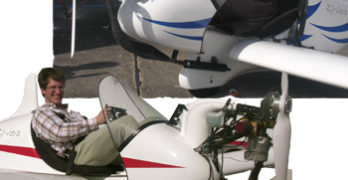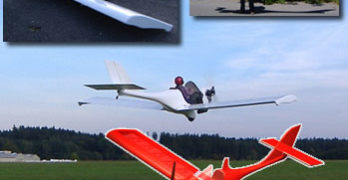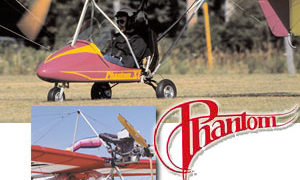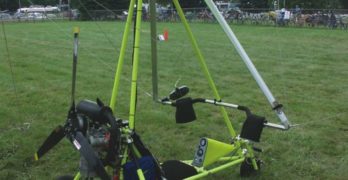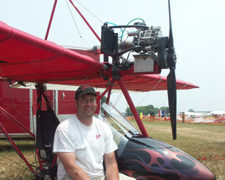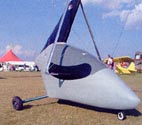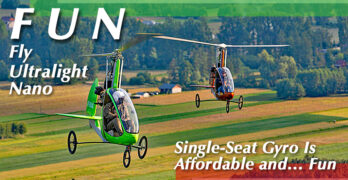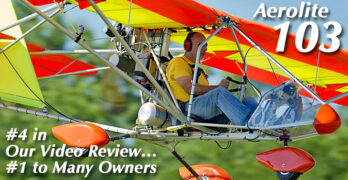Alert: This article is dated and some links may no longer lead to the desired destination. —DJ 0121
Maybe you’ve heard: “You can’t build a three axis airplane that can safely remain under the 254-pound weight limit.”
Some allege: “You can’t buy a three axis Part 103 ultralight that actually meets the rule.”
I’ve said this many times… WRONG!
You have a few choices for Part 103 airplanes that perform well and they aren’t all trikes or powered parachutes (though several qualifying candidates do come from these segments). I’ll soon post fresh articles on the Kolb FireFly and Phantom X-1. Each can meet Part 103.
Now, we have what may be the first all-new Part 103 ultralight in many years. ZJ Viera was designed in Europe by Marek Ivanov, CEO of Interplane Aircraft (photo). At Sebring 2008, plenty of attendees spent time examining the two examples present; one was the original monowheel (which I tend to prefer) and a tri-gear variation.
Search Results for : Part 103
Not finding exactly what you expected? Try our advanced search option.
Select a manufacturer to go straight to all our content about that manufacturer.
Select an aircraft model to go straight to all our content about that model.
See Nothing New in Part 103 Airplanes? Look Again!
Even though FAA has said Part 103 will not be changed, many pilots see few fixed wing airplane choices truly meeting the definition.
Some trikes and powered parachutes can manage it but many lament, “Yeah, but no three-axis designs.” If you agree, be prepared to eat your words. Here comes Interplane’s ZJ Viera.
The brand-new composite design is no dream. It’s gone through a proof-of-concept stage and is now flying as a preproduction prototype. Those attending Sebring Expo 2008 can visit importer LSA America‘s display.
Does it genuinely make weight, the toughest part of F.A.R. Part 103? Based on factory info…YES, and by a generous margin!…thanks to modern materials and simple design.
Will ZJ be affordable? “Yes,” says former Interplane owner Ralph Mandarino. The company priced a basic ready-to-fly monowheel ZJ at $19,800. They’re flying it with the Hirth F33 but as it appears well under the max empty weight of 254 pounds, ZJ engineer and Interplane CEO Marek Ivanov could investigate other engines including four-stroke or electric.
FAA, No Changes for Part 103 Ultralights
If you fly a two-seat ultralight, I hope you’re aware of a big change just ahead: the January 31, 2008 deadline when you must transition such aircraft to Experimental LSA. Some have acted already. Many have not. FAA says that date is firm and will not change. *** But outgoing FAA Adminstrator Marion Blakey also said “No change to Part 103.” Called “Ultralight Vehicles” (not “aircraft”), this distinction now means something special. The Part 103 rule for single seaters rather quietly counted its 25th birthday in September 2007. This low-key event also celebrates aviation’s simplest rule — the entire FAR can be printed on a single sheet of paper!…and it is still alive and well. *** Examples like the Phantom ultralight have excellent flight characteristics and low prices. In late 2007, a Phantom X-1 kit is less than $15,000 and you can legally pay someone to build it for you.
FAA, “No Changes for Part 103 Ultralights”
If you fly a two-seat ultralight, I hope you’re aware of a big change just ahead: the January 31, 2008 deadline when you must transition such aircraft to Experimental LSA. Some have acted already. Many have not. FAA says that date is firm and will not change. *** But outgoing FAA Adminstrator Marion Blakey also said “No change to Part 103.” Called “Ultralight Vehicles” (not “aircraft”), this distinction now means something special. The Part 103 rule for single seaters rather quietly counted its 25th birthday in September 2007. This low-key event also celebrates aviation’s simplest rule — the entire FAR can be printed on a single sheet of paper!…and it is still alive and well. *** Examples like the Phantom ultralight have excellent flight characteristics and low prices. In late 2007, a Phantom X-1 kit is less than $15,000 and you can legally pay someone to build it for you.
Part 103 Ultralights Shine
even in a Light-Sport Aircraft World.
Despite the intense focus on the FAA’s new Sport Pilot/Light-Sport Aircraft rule, EAA’s big summertime airshow brought the introduction of at least four intriguing, legitimate ultralights—aircraft that truly meet the 254-pound rule. Many observers believed LSA would sound the death knell for Part 103. I guess not!
Not only were new ultralights common, their diversity was broad. You could see a fixed-wing, a weight-shift trike, a powered parachute and a helicopter. As if seeking to prove the new rule won’t eliminate Part 103, these machines were proudly displayed by vendors who also supply larger, heavier models.
Skymaster Light Trike
One bright spot at EAA AirVenture was—literally—the glowing yellow Skymaster Light Trike. Excellent detailing kept viewers looking carefully.
Mike Lane is the man behind the project at Skymaster. He’s a hang-glider pilot looking for an easy way to launch in the flatlands of Wisconsin. His ultralight vehicle benefits from the supply bins at Skymaster powered parachutes, helping this prototype look production ready.
Innovating for Part 103 Ultralights
How can a Part 103 use a four-stroke engine? Well, you can elect the half-VW from Hummel…or you might try a rotary engine as seen at the 2005 Mid-Atlantic Fly-in. This innovative racing cart engine is being developed for Part 103 ultralight use (yes, to make the weight, with electric starter!) by Erik Pederson, the new president of Phantom Aeronautics. Impressively educated, Eric has a BS in Aero Engineering plus an MS and PhD in Mechanical Engineering. Watch for a test report when Erik is satisfied with the performance.
Part 103 Ultralight Trikes
Part 103 ultralight trikes aim at soaring pilots.
Many visitors to Oshkosh AirVenture 2003 expected the FAA to announce its new sport pilot/light-sport aircraft rule. New Administrator Marion Blakey reported signing off on the rule on July 30, but with two other agencies in line to review it, we aren’t likely to see the final version until 2004.
Visitors may not have expected to see more than a few Part 103 ultralight aircraft at AirVenture (some thought they would disappear as LSA approaches). But there were many. Next month I’ll write about two Part 103 rotary-wing aircraft, but this time, the subject is nanotrikes.
Nanotrike is a term to describe extremely light wheeled structures combining powered paraglider engines and contemporary hang glider wings. The idea is to create a low-cost, self-launching ultralight motorglider.
Trike Pod
Minnesota-based Seagull Aerosports debuted its Escape Pod at Oshkosh. Pushed by a single-cylinder Cors-Air engine generating 25 hp, the Escape Pod weighs only 75 pounds.
“Charming” and Affordable, Part-103 JK-2 Nano Now Propelled by 50-Horsepower Engine
“When I roll up to the terminal on any airport, it never ceases to amaze me how a small crowd will gather around the aircraft. Happens almost every time,” said Jeffrey Boyd, importer of the JK-2 Nano single-seat gyroplane. “They just think it looks cute and different. Then they find out it’s quite affordable.”
I reflected back that this cleanly executed Nano had the same effect on me when I first saw it at AirVenture Oshkosh 2021. A glance at this eye-catching design, beautiful in its simplicity and compact in its features (see on trailer or in shipping crate) suggested to me that JK-2 Nano could find a market.
For more than a decade, interest in gyroplanes has been strong. After European designers took earlier American simple gyros and transformed them into sleek aircraft, a wider range of pilots looked at them more positively. However, those more elegant and feature-laden designs steadily rose in price.
Building the Affordaplane, Part 2
In a previous post, introduced our video project for building the Affordaplane. To review, this is the plans-only project I demonstrated on YouTube for building an ultralight from raw materials. (You’ll find this free 50-part series here.)
My objective was to build an “FAA-legal” ultralight using approved aircraft materials and techniques. This month, I will review some of the challenges encountered while building. My approach on making these videos was to show and explain to first-time builders how to take a set of plans and translate them into a series of steps for completing the project.
From a construction standpoint this ultralight design is quite unusual in some ways and very traditional in others. The designer, Dave Edwards, had a goal of making sure the aircraft could be built by an amateur with common shop tools and readily available materials.
Back to Our Top-50 Videos — Aerolite 103 May Be the Top Seller Among True Ultralights
Among the couple hundred readers who commented on my recent Mosaic article, several referenced Private Pilots who consider a Sport Pilot to be “unqualified.” I’ve heard that, too. In fact, I’ve heard similar comments my entire long career.
It’s a pecking order thing, I suppose, a natural human response, but I dislike when one aviator puts down another. Is a hang glider pilot somehow less than a power pilot? Is a LSA pilot doing a lesser job flying than a GA pilot? Indeed, is the humble prop pilot somehow less than a jet pilot? Are pilots who like rotary or seaplanes oddballs? I think not but such opinions are too-commonly heard.
Similarly, why are pilots so ill-informed about Part 103? Most pilots have heard of the category yet most of them know next-to nothing about the aircraft type. Contrarily, I can say this: the ones who learn about Aerolite 103 know this is a right-proper light aircraft and they want more… for less.
- « Previous Page
- 1
- …
- 4
- 5
- 6
- 7
- 8
- …
- 53
- Next Page »


